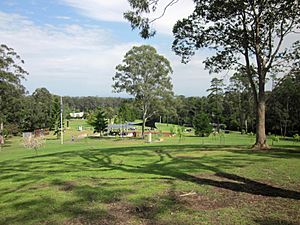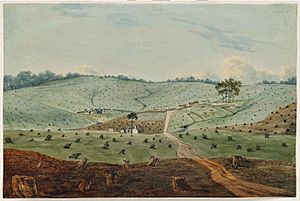Third Government Farm facts for kids
Quick facts for kids Third Government Farm |
|
|---|---|

Castle Hill Heritage Park (Third Government Farm)
|
|
| Location | Gilbert Road, Castle Hill, The Hills Shire, New South Wales, Australia |
| Built | 1801 |
| Owner | The Hills Shire Council |
| Official name: Third Government Farm (former); Castle Hill Heritage Park; Castle Hill Settlement Site; Old Government Farm Site; Castle Hill Convict Farm; Castle Hill Historic Site | |
| Type | State heritage (landscape) |
| Designated | 22 December 2000 |
| Reference no. | 1448 |
| Type | Other - Landscape - Cultural |
| Category | Landscape - Cultural |
| Lua error in Module:Location_map at line 420: attempt to index field 'wikibase' (a nil value). | |
The Third Government Farm is a very old and important place in Castle Hill, Australia. It's now known as Castle Hill Heritage Park. This site was built in 1801 and has a rich history, especially linked to a major event called the Castle Hill convict rebellion.
Today, The Hills Shire Council owns this special park. It was added to the New South Wales State Heritage Register in 2000 because of its historical importance.
Contents
A Glimpse into History: Castle Hill's Past
Castle Hill Heritage Park is famous for its connection to the Castle Hill convict rebellion. This event is also known as the Second Battle of Vinegar Hill. It's a key part of Australia's history, especially for understanding early European conflicts.
The Convict Rebellion: A Fight for Freedom
The Second Battle of Vinegar Hill was a rare armed fight between Europeans in Australia. It happened in 1804, long before the Eureka Stockade. About 300 rebels, mostly Irish convicts, fought against soldiers. Many of these convicts had been sent to Australia for their part in political uprisings in Ireland.
The rebels used the phrase "Death or Liberty." While some believe they fought due to harsh conditions and lack of food, it was likely a political act. Many Irish convicts did not accept English rule. They continued their fight for freedom even in the new colony.
Why the Uprising Happened
The exact reasons for the rebellion are still a bit unclear. There aren't many official records from that time. This might be because Governor King didn't want to look bad. He had gathered many Irish political prisoners in one remote spot, which might have seemed like a risky idea.
After the rebellion, the convicts who survived were separated. This was to prevent them from organizing another group action. Their story is a significant, yet often untold, part of Australia's past. For a long time, this important event wasn't widely recognized.
Key Moments at the Farm
Many important events happened at this site over the years:
- 1801: Work began on the Third Government Farm. The soil was thought to be very good for growing crops.
- 1803: A painting showed the farm was mostly cleared. It had buildings, tracks, and farmed areas.
- March 4, 1804: The Vinegar Hill uprising took place. A building on the farm was set on fire.
- 1811: The farm was turned into a hospital for people with mental health challenges. It was meant to hold 30 people.
- 1826: The hospital closed, and the patients moved to Liverpool.
- November 1826: The old hospital building became a church.
- Around 1886: The old hospital building was pulled down. Its stones were used to build the rectory for St Paul's Anglican Church.
- Early 1900s: The land was used for growing fruit, like an orchard.
- 1930s-1940s: Fruit growing slowed down, and the land became pasture for animals.
- 2004: The park was updated and reopened as Castle Hill Heritage Park. The Governor of New South Wales, Professor Marie Bashir, opened it.
Exploring the Park: What You Can See Today
Castle Hill Heritage Park has changed a lot over time. While there are no original buildings left, you can still see signs of its past.
Old Foundations and Hidden History
Even though no old buildings stand, the park holds many secrets underground. Archaeologists have found the sandstone wall footings of the old barracks and kitchen. These discoveries help us understand what the farm looked like long ago.
The Trees and Plants
Most of the native trees you see today grew back after 1816. By 1943, many native trees had regrown along the gullies. The forest spread even more after 1961.
The main type of tree here is the Sydney Blue Gum (Eucalyptus saligna). Other trees like Blackbutt (Eucalyptus pilularis) and Apple (probably Angophora floribunda) were also noted in early surveys.
How the Land Was Used
The land changed a lot from its natural state. Early settlers cleared many trees to create the farm.
The Government Farm Era
In the beginning, almost all trees and bushes were removed. Only a few trees were left in one spot. The cleared areas were used for animals and crops.
- The main buildings were on a low ridge.
- A flat area might have been a meeting point for convicts.
- There was a barnyard and a garden for the superintendent.
Asylum and Church Times
Later, when the site became a hospital and then a church, two main areas were used:
- The yard and garden around the hospital/school.
- The area where the main hospital buildings (later the church) stood.
Other parts of the site were likely used for grazing animals.
The Orchard Years
During the time it was an orchard, much of the southwest part of the park was used for growing fruit. One interesting feature from this time is the remains of a quarter-mile long dog racing course. You can still see it on the western side of the park. There's also an old brick water tank from the mid-1900s.
Hills, Valleys, and Waterways
The park has four main types of land:
- High slopes in the north and east.
- Gentle slopes.
- A flat area near Banks Road.
- A central gully with a creek and sandstone rocks.
These natural features haven't changed much since European settlement. The small flat area, surrounded by hills and with good soil, probably led to this spot being chosen for the farm. The creek was likely the first water source for the people living there. The hills around the farm also created a natural boundary, giving the area its name, "Castle Hill."
Why Castle Hill Heritage Park Is Special
Castle Hill Heritage Park is very important to New South Wales' history.
A Place of Rebellion and Firsts
It's closely linked to the Battle of Vinegar Hill in 1804. This event is a key part of Irish nationalist movements from long ago. The park also shows how the early colony expanded westward using convict labor. It highlights the challenges of starting agriculture in new areas.
Later, the site became Australia's first dedicated mental health facility (from 1811 to 1828). This adds another important layer to its history. Its use as a church and school, and then for orchards, also makes it significant locally.
Connecting with the Past
The park's landscape still shows the original layout of the Third Government Farm. It helps us imagine what the area looked like in the 1800s.
The orcharding phase might be important to people whose families were early orchardists in the area. Also, the church and school were central to the community for many years.
Uncovering Secrets
Archaeological finds at Castle Hill, and other possible discoveries, can help us learn more. They can answer questions about how convicts and mental health patients were treated. They can also shed light on the reasons for the Battle of Vinegar Hill and early farming efforts near Sydney.
A Rare and Unique Site
This park is one of only two places in Australia where an armed rebellion was planned and started. It was also the first hospital for people with mental health challenges in the colony, making it very rare. The cultural landscape of the site is also special because it's a convict farm site that hasn't changed much over time.
Castle Hill Heritage Park is a great example of a convict farm site from the 1800s that still shows its original features.
The Third Government Farm was officially listed on the New South Wales State Heritage Register on December 22, 2000.


